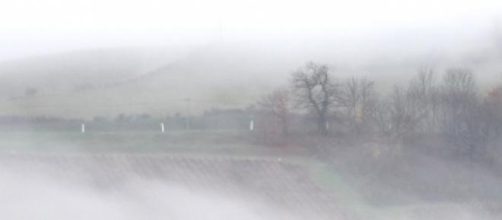As we drove to higher terrain, the heavy morning mist along the Saône river gave way to orange sun rays colouring patches of fog still clinging to the hill tops. The November morning was crisp, with a slight westerly wind that brought scents of burning from the pruning in the vineyards below.
We parked the car at the summit dominating the beautiful town of Fleurie in the heart of the Beaujolais, one of the most renowned wine regions in France. Although bordering with the Burgundy region, the Beaujolais area produces wines that are distinct and singular, as everything from the grape to the soil, as well as the unique microclimate provide an exceptional produce here in the gently rolling slopes just north of Lyon.
From our parking area at Col de Laborouns, we took to a light jog along the compact sand path through the forest, past le Sous towards la Cabane des Chasseurs above the village of Chenas. This is one of the many peaks in the area, which on a clear day like today offers a fantastic view all the way to Mont Blanc.
It was the faith of Phillip II the Bold, Duke of Burgundy, to ensure Beaujolais' fame as one of the most distinct wines in the old and new world combined. He banned the Beaujolais grape Gamay as a "disloyal plant" in the rest of the Cote d'Or district in favour of the Pinot varieties. This left "les metayers" - the Beaujolais wine farmers - as the only ones allowed to grow the Gamay.
Anyone with a minimal knowledge of grapes will immediately realize this grape is quite different from at least the edible consumer kinds. The Gamay grapes come in all different incoherent sizes. It is also common knowledge that the Gamay grape is far from the easiest to grow. But then, as often cited in mountainous areas: "you don't get to the mountains on a flat road". Success comes with effort. But then, success can be a pitfall too..
And indeed. The wines of Beaujolais have experienced a roller coaster of highs and lows over the past decades. During the height of its fame, the farmers started to overproduce and some are even said to have blended non-Beaujolais grapes and sugar into the wine.
Added to that, the region's newest success, the fresh Nouveau wine, was not performing as well as anticipated and being produced in too large quantities. Producers sought to capitalize on the success of the newest trend and forgot the most basic of of all marketing and branding principles starting with a capital "Q".
Evil tongues will even put forth that the Nouveau is nothing but a sales campaign to get rid of the overproduced lesser wines from the South, and leave the true branding to the Crus and Villages in the North. Or so it is said. Truth is, Beaujolais - as most other wine districts in Europe - has had its share of scandals, but has managed to step back from the abyss.
Mont Blanc shined gloriously in the horizon - already covered in a mantle of white anticipating the approaching winter.The faint barking from hunting dogs in the surrounding forests floated up towards us.
We headed back to the car, the morning already well advanced, coffee and fresh baguettes waiting. As we rolled back down towards the plains, my companion and I fell silent as we watched grey herons gracefully taking flight as we drove past.
Despite stories, rumors and possibly deliberate tainting, we were now ready. Ready for one of the most renowned, least valued and yet one of the loveliest follies in the World, which would follow later that day: the release of the 2014 Beaujolais Nouveau wine. "À votre santé" - to your health, and Merry Christmas!

